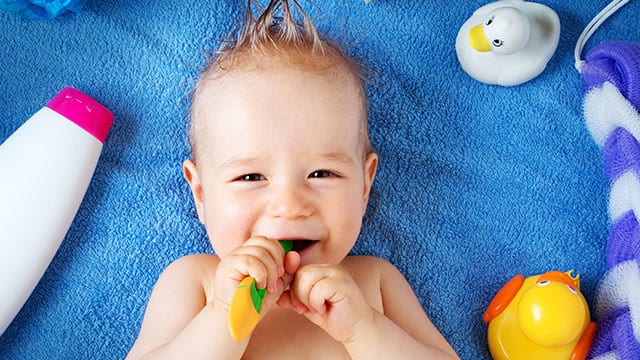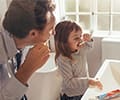When Should You Use Toothpaste For Your Baby's First Teeth?
Once baby’s first teeth erupt or once they have several teeth, that’s when to start adding a tiny smear of toothpaste to a baby’s brushing routine. Fluoride is a mineral that can prevent tooth decay. In the past, dentists recommended children under the age of 2 use fluoride-free toothpaste. The American Academy of Pediatrics has updated those guidelines and recommend fluoride toothpaste at all ages, provided you use it sparingly under direct parental supervision. Use a “smear” (the size of a grain of rice) of fluoride toothpaste as soon as your baby has teeth. Upgrade to a pea sized amount around the age of 3 when they can spit it out.
Baby's First Brush
Even before your baby starts getting teeth, you can begin practicing good oral health habits. Use a soft-bristled infant toothbrush or finger brush and a light touch when cleaning your baby's gums. You only need to use water at this stage — no toothpaste necessary. Gently massage their gums and get your baby used to the feeling of the toothbrush in their mouth. Show your baby that brushing is a pleasant experience, not something that should be frightening or irritating.
First Tooth
As noted above, as soon as that first, precious little tooth erupts, your baby is ready for real brushing! Here's your getting-started checklist:
If you choose to use a toothpaste with fluoride, follow the American Dental Association (ADA) recommendation to use a smear — about a rice-sized amount — of toothpaste.
How To Choose Baby Toothpaste
When your child is ready to start using toothpaste, there are a few options to consider. You can choose a fluoride-free toothpaste that's designed for kids under two years old, as well as toothpastes that are free of artificial colors, preservatives or sodium lauryl sulfate. You can also choose to use fluoride toothpaste, if you consistently apply a rice-sized amount of toothpaste. Since your baby is not old enough to brush on their own, adult supervision can ensure they get the right amount of toothpaste to avoid swallowing large amounts. Baby toothpastes tend to be milder to help make it a pleasant experience for sensitive tastebuds.
Most young children don't enjoy strong flavors — the minty-fresh toothpaste you might enjoy could make your child cringe. Taste your little one's new toothpaste before using it in their mouth.
Is Fluoride Toothpaste Safe?
You can begin using fluoride toothpaste from the beginning, just start with a tiny amount, the size of a grain of rice, says the ADA, and encourage your child to spit after each brushing. Kids between 3-6 years old can use a pea-sized amount. It's important to ensure that your kiddo can spit out their toothpaste, so they don't ingest fluoride.
Dental fluorosis can happen when a young child ingests too much fluoride before their adult teeth erupt. This condition causes white or brown discoloration or spots on the enamel, or tooth surface.
To be sure of the right time to switch your child over to fluoride toothpaste, discuss your child's dental care needs with your dentist or pediatrician.
Treasure The Memory
Teeth brushing is a milestone! Take some pictures and videos at every stage of that beautiful little smile. From brushing with water to using fluoride, you can care for your baby's mouth to set them up for a lifetime of positive oral health habits!
Oral Care Center articles are reviewed by an oral health medical professional. This information is for educational purposes only. This content is not intended to be a substitute for professional medical advice, diagnosis or treatment. Always seek the advice of your dentist, physician or other qualified healthcare provider.
ORAL HEALTH QUIZ
What's behind your smile?
Take our Oral Health assessment to get the most from your oral care routine
ORAL HEALTH QUIZ
What's behind your smile?
Take our Oral Health assessment to get the most from your oral care routine
Join Us
Get the best of your oral health routine and take it to the next level with expert advice, recommendations, products and solutions and special offers.
Join Us
Get the best of your oral health routine and take it to the next level with expert advice, recommendations, products and solutions and special offers.















